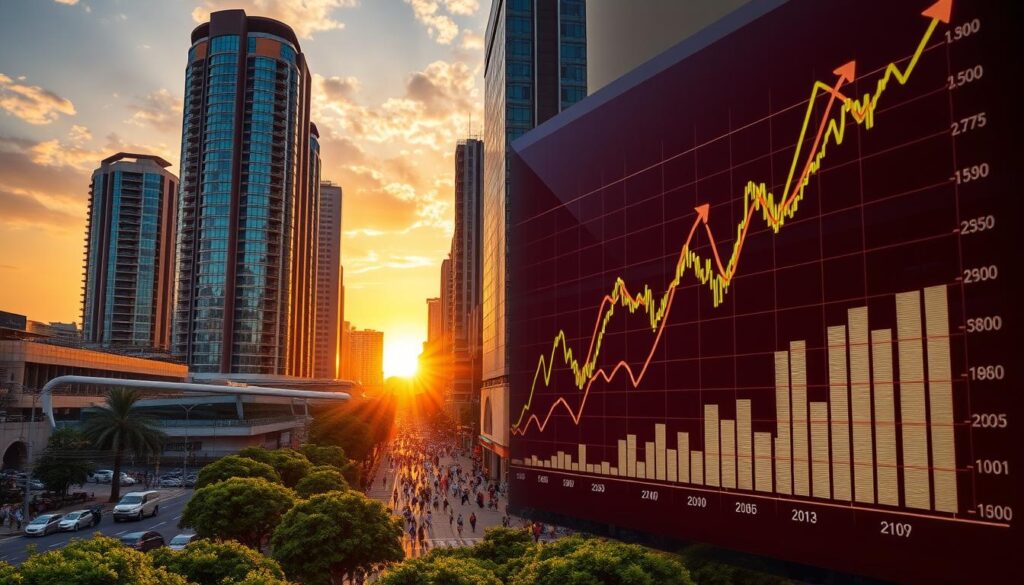Tourism Sector Rebounds Driving 2023 Economic Growth
Sri Lanka’s tourism industry is bouncing back in 2023, despite recent challenges. The sector employs nearly half a million people directly. It also supports millions more indirectly.
Recent data shows tourist arrivals more than doubled in 2022, reaching 1.5 million. Early signs suggest Sri Lanka may outpace the Maldives as a top destination.
International tourists are flocking to Sri Lanka’s natural beauty and rich culture. Domestic tourism is also on the rise. Locals are rediscovering their country’s wonders.
This boost in tourism, both international and domestic, is set to fuel Sri Lanka’s economic recovery. The hospitality sector’s growth is expected to play a key role in 2023.
Key Takeaways
- Sri Lanka’s tourism sector is showing strong signs of recovery in 2023, despite recent challenges
- Tourist arrivals more than doubled in 2022 compared to 2021, reaching 1.5 million
- Sri Lanka is on track to surpass the Maldives as a top tourist destination in 2023
- The travel industry revival is driven by both international tourism trends and a boost in domestic tourism
- The hospitality sector growth is expected to contribute significantly to Sri Lanka’s economic recovery in 2023
Sri Lanka’s Tourism Industry Poised for Recovery
Sri Lanka’s tourism sector is bouncing back in 2023. Tourist arrivals and spending have increased significantly. From January to August, 904,318 visitors came, surpassing 2022’s total arrivals.
This surge has boosted the economy. Tourism receipts reached US$1,136.30 million in 2022. In the first half of 2023, they hit US$875 million. This economic impact is notable.
Increased Tourist Arrivals and Spending in 2023
Visitors from various regions are driving the recovery. Sri Lankan Airlines, Qatar Airways, and Emirates led market shares in 2022. This shows strong demand for travel to Sri Lanka.
The economy grew 5 percent in early 2024. This growth came from tourism-related services and industry. Construction and food manufacturing also contributed.
International Airlines Resume Operations to Sri Lanka
Many international airlines have resumed full-time operations to Sri Lanka. Qatar Airways, Singapore Airlines, and Emirates are back. Thai AirAsia, Air China, and Air France have started new routes.
This increased connectivity boosts tourist arrivals. It also creates more tourism employment opportunities.
Cruise Tourism Shows Promising Growth
Cruise tourism is gaining interest. Various cruise lines are choosing Sri Lanka as a destination. March 2024 is expected to be busy for cruise arrivals.
The industry’s recovery continues. The government and private sector focus on sustainable tourism. This approach aims to ensure long-term growth and development.
Tourism Sector Rebounds, Contributing to Economic Recovery in 2023
Sri Lanka’s tourism sector is bouncing back, fueling economic growth in 2023. It’s now the third largest foreign exchange earner, creating jobs and boosting the economy. In 2023, Sri Lanka welcomed 1,487,303 tourists, doubling the previous year’s numbers.
Europe and Asia-Pacific regions brought in most visitors. This aligns with global trends, as international tourism hit 88% of pre-pandemic levels. The World Tourism Organization expects full recovery by 2024.
Sri Lanka’s tourism outlook is promising. The government and businesses are investing in luxury hotels. They’re also promoting destinations to high-spending tourists from Europe and other regions.
These efforts aim to increase foreign exchange earnings. Tourism businesses keep most earnings within the country. This helps drive economic recovery and create jobs.
The sector shows resilience despite global economic challenges. Air passenger numbers and hotel occupancy are rising. This proves tourism’s potential to boost economic growth.
Sri Lanka continues to improve its tourism infrastructure. It’s also promoting unique attractions. These actions position tourism as a key player in the country’s economic recovery.
Government Initiatives and Private Sector Investments Fuel Tourism Growth
Sri Lanka’s government is offering beachfronts and islets for tourism development. They’re encouraging public-private partnerships to boost investment and expertise. This strategy aims to drive economic recovery through tourism infrastructure development.
Private investors are jumping into the resurgent tourism market. Hotelier Angeline Ondaatje is building luxury hotels for high-end European travelers. These hotels focus on Buddhist spirituality and Ayurvedic medicine.
Experts suggest the Tourism Board launch targeted marketing campaigns in Europe. They should highlight Sri Lanka’s unique attractions. These include world-class surfing at Arugam Bay and abundant wildlife sanctuaries.
Sri Lanka’s tourism sector is ready for a strong comeback. The country can use its natural and cultural assets to boost the economy. This growth can create new opportunities across the island nation.



